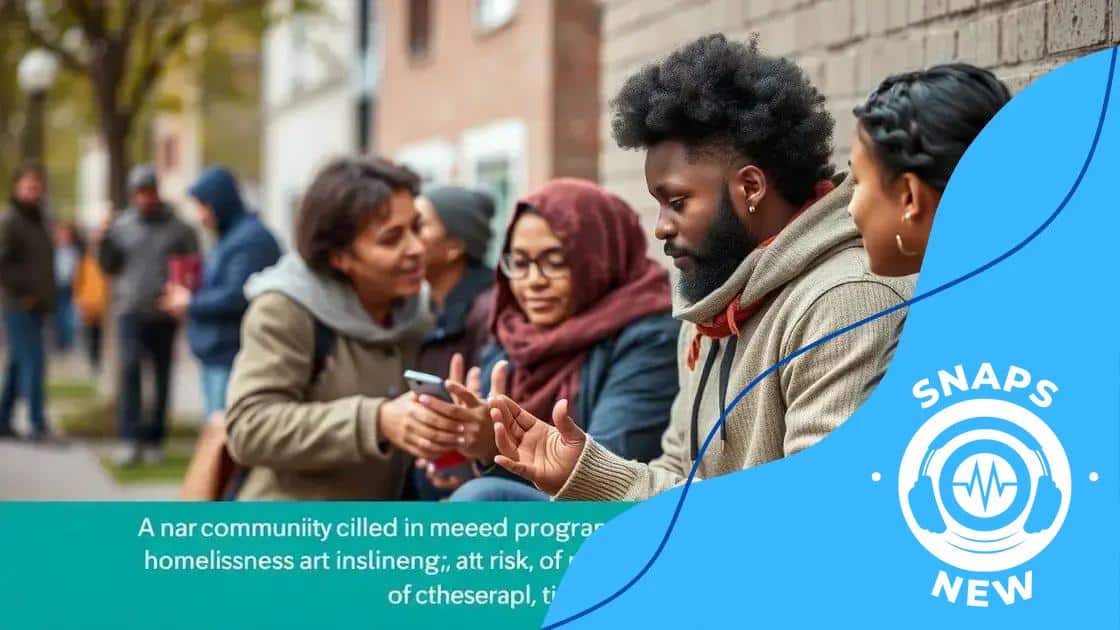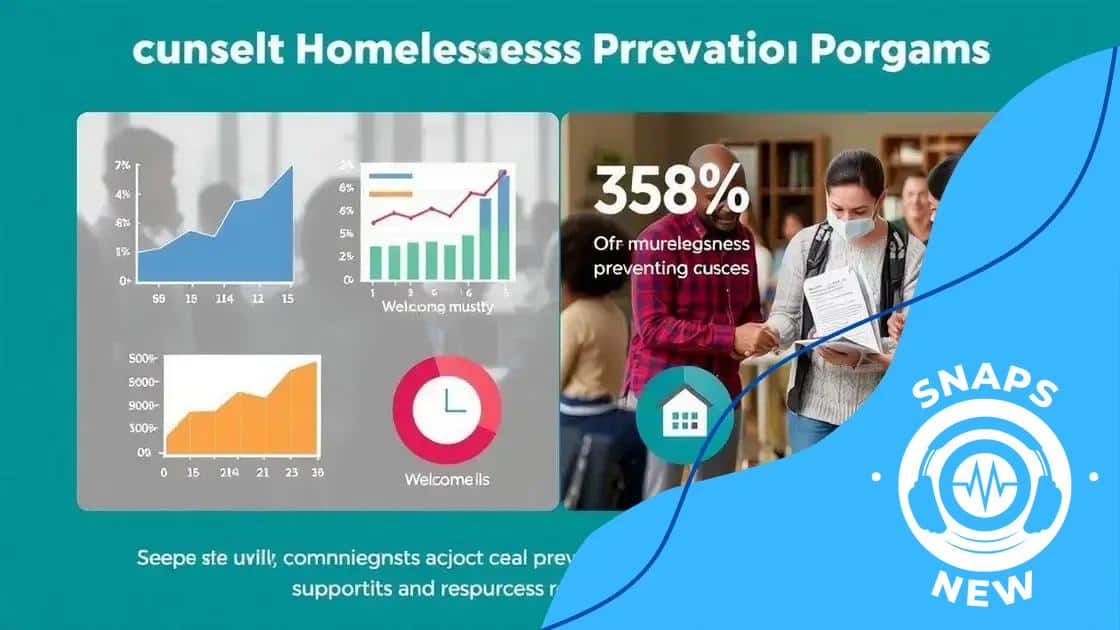Homelessness prevention programs: how they make a difference

Homelessness prevention programs provide crucial support and resources to individuals and families at risk of losing their homes, focusing on stability, financial assistance, and community involvement to create lasting solutions.
Homelessness prevention programs play a crucial role in supporting individuals at risk of losing their homes. You might wonder, how can these initiatives truly change lives? Let’s dive into their importance and effectiveness.
Understanding homelessness: key causes
Understanding the causes of homelessness is essential to effectively tackle this complex issue. There are several factors that contribute to homelessness, and recognizing them can lead to better prevention strategies.
Economic challenges often top the list. Many individuals face job loss, low wages, or unexpected expenses that can quickly lead to losing their homes. Additionally, the rising cost of living in many areas places significant pressure on vulnerable populations.
Common Causes of Homelessness
Aside from economic factors, other elements play a significant role in homelessness:
- Housing affordability: Many people struggle to find affordable housing due to increasing rent prices.
- Mental health issues: A number of individuals experiencing homelessness deal with untreated mental health conditions.
- Substance abuse: Challenges with addiction can lead to instability and loss of housing.
- Family and domestic issues: Situations like domestic violence or family disputes often result in individuals fleeing their homes.
Understanding these factors is crucial for developing effective solutions. Programs focusing on job training, mental health services, and affordable housing initiatives can directly address the root causes of homelessness. By identifying the underlying issues, communities can create more holistic approaches to prevention.
Another vital aspect to consider is the impact of systemic issues like racism and inequality. Many marginalized communities face disproportionate rates of homelessness due to historical disadvantages. Addressing these systemic barriers is necessary for effective long-term strategies.
Awareness and education about the causes of homelessness can help reduce stigma and encourage support for those in need. As we shed light on these challenges, we can foster a more empathetic and informed community.
The role of prevention programs
The role of prevention programs in addressing homelessness is crucial. These programs are designed to provide support and resources to individuals and families at risk of losing their homes. By implementing effective strategies, communities can significantly reduce the number of people experiencing homelessness.
One major aspect of these programs is to offer financial assistance for rent and utilities. This support can help prevent eviction, allowing families to stay in their homes during difficult times. In addition to financial aid, many programs also focus on case management to help individuals navigate social services.
Key Functions of Prevention Programs
Prevention programs provide a range of services that empower individuals and strengthen families:
- Housing stability: Maintaining stable housing is a central goal, which programs achieve by offering support.
- Employment resources: Many initiatives help individuals find jobs or improve their job skills, fostering self-sufficiency.
- Crisis intervention: Programs often include urgent support for families facing immediate threats of homelessness.
- Community connections: By linking families to local resources, programs help create supportive networks.
Beyond these services, prevention programs also play an educational role. They often provide workshops on budgeting, tenant rights, and available community services. Such resources can equip individuals with the knowledge they need to make informed decisions.
Another important consideration is that prevention programs frequently collaborate with local organizations to maximize their impact. These partnerships allow for a comprehensive approach, addressing various aspects of homelessness from different angles. By bringing together resources, communities can more effectively combat the factors leading to homelessness.
Innovation is also a key component in the role of prevention programs. Many are exploring new technologies and strategies to reach those in need more efficiently. As these programs evolve, their effectiveness in preventing homelessness continues to improve.
Successful case studies and statistics

Examining successful case studies and statistics is vital to understanding the impact of homelessness prevention programs. These examples show how targeted actions can effectively reduce homelessness in various communities.
One remarkable case is from a city that implemented a housing-first approach. This method provides stable housing without preconditions, allowing individuals to focus on recovery and stability. In the first year alone, this city saw a 30% reduction in homelessness rates.
Notable Success Stories
Several cities have achieved significant improvements through innovative programs:
- Seattle: The city’s proactive eviction prevention efforts decreased homelessness by 29% over three years.
- Minneapolis: A combined effort of local nonprofits and government agencies led to a 25% drop in homelessness in just two years.
- New York City: One initiative reported that investing in supportive housing resulted in 85% of participants maintaining their housing.
- Los Angeles: A comprehensive outreach program helped connect over 10,000 individuals with resources in its first year.
Statistics from these programs highlight their effectiveness. For instance, a national survey shows that prevention programs can lead to a 60% success rate in keeping families housed. These numbers illustrate how timely intervention can keep people off the streets.
Additionally, data shows that providing support during critical moments, such as before eviction, can dramatically change outcomes. Communities that focus on early intervention decrease the need for emergency services, ultimately saving taxpayer money.
Evaluating these success stories and statistics demonstrates that the right resources and approaches can create lasting change in people’s lives. As more programs emerge, it is essential to continue measuring their impact and sharing these findings.
Community resources and support
Community resources and support play a fundamental role in preventing homelessness. These resources provide essential services that help individuals and families maintain stable housing and improve their overall well-being.
Local organizations often offer a variety of assistance programs tailored to meet the needs of different populations. For instance, food banks and shelters help ensure that basic needs are met, reducing the risk of eviction. Additionally, these organizations work to connect individuals with financial aid programs that can cover rent and utility bills.
Key Resources Available
Many communities provide specific resources aimed at stabilizing housing situations:
- Emergency shelters: Safe spaces that offer temporary housing for families and individuals in crisis.
- Job training programs: These provide skills and employment opportunities, helping individuals become self-sufficient.
- Counseling services: Support for mental health and addiction issues, recognizing that these can be underlying causes of homelessness.
- Legal aid: Assistance with tenant rights and eviction processes to help prevent families from losing their homes.
Community resources also include outreach programs that actively seek to engage those at risk of homelessness. These outreach efforts often provide direct connections to support services, ensuring that individuals get the help they need as early as possible. These proactive measures can drastically reduce the number of people facing homelessness.
It’s important to highlight the role of community engagement in these processes. Local volunteers often contribute their time and skills to help run programs and events that raise awareness about available resources. This kind of support strengthens community ties and encourages collaboration among service providers.
Additionally, schools and faith-based organizations also play a critical role in bridging gaps in support. They often have existing relationships with families, allowing them to identify needs early and connect families with appropriate resources. An integrated approach ensures that individuals and families can receive holistic support during crises.
How to get involved and help
Getting involved and helping those facing homelessness is a meaningful way to contribute to your community. There are many ways individuals can make a positive impact, whether through direct support or by raising awareness of homelessness issues.
One effective way to help is by volunteering your time at local shelters or food banks. These organizations often rely on volunteers to carry out daily operations and provide essential services. Even a few hours a week can make a significant difference in the lives of those in need.
Ways to Get Involved
Consider the following opportunities to engage in your community:
- Volunteer at shelters and food banks: Support efforts by serving meals or distributing food and supplies to families.
- Donate items: Contribute clothing, toiletries, or non-perishable food to shelters and organizations that support individuals experiencing homelessness.
- Advocate for policy change: Join local advocacy groups working to create long-term solutions for homelessness, such as affordable housing initiatives.
- Raise awareness: Use social media or community events to educate others about homelessness and encourage them to take part in efforts to help.
Another impactful action is to support local charities financially. Many organizations rely on donations to function and expand their services. By giving, you can help these organizations provide essential resources like mental health services and job training programs.
Additionally, consider organizing a fundraiser or community event to benefit local homelessness prevention programs. Engaging friends, family, and neighbors can foster a sense of community and encourage collaboration.
It’s also important to learn about the complexities of homelessness. Understanding the issues that contribute to homelessness can guide more effective action. By educating yourself and others, you help break down stereotypes and reduce stigma, creating a more supportive environment.
FAQ – Frequently Asked Questions about Homelessness Prevention Programs
What are homelessness prevention programs?
Homelessness prevention programs are initiatives designed to provide support and resources to individuals and families at risk of losing their homes.
How can I help prevent homelessness in my community?
You can help by volunteering at local shelters, donating items, advocating for affordable housing policies, or raising awareness about homelessness issues.
What resources are available for those at risk of homelessness?
Resources include emergency shelters, food banks, job training programs, legal aid, and counseling services to support individuals and families.
Why is community involvement important in preventing homelessness?
Community involvement brings together resources and support, creating a network that can effectively address the complexities of homelessness and empower individuals.





